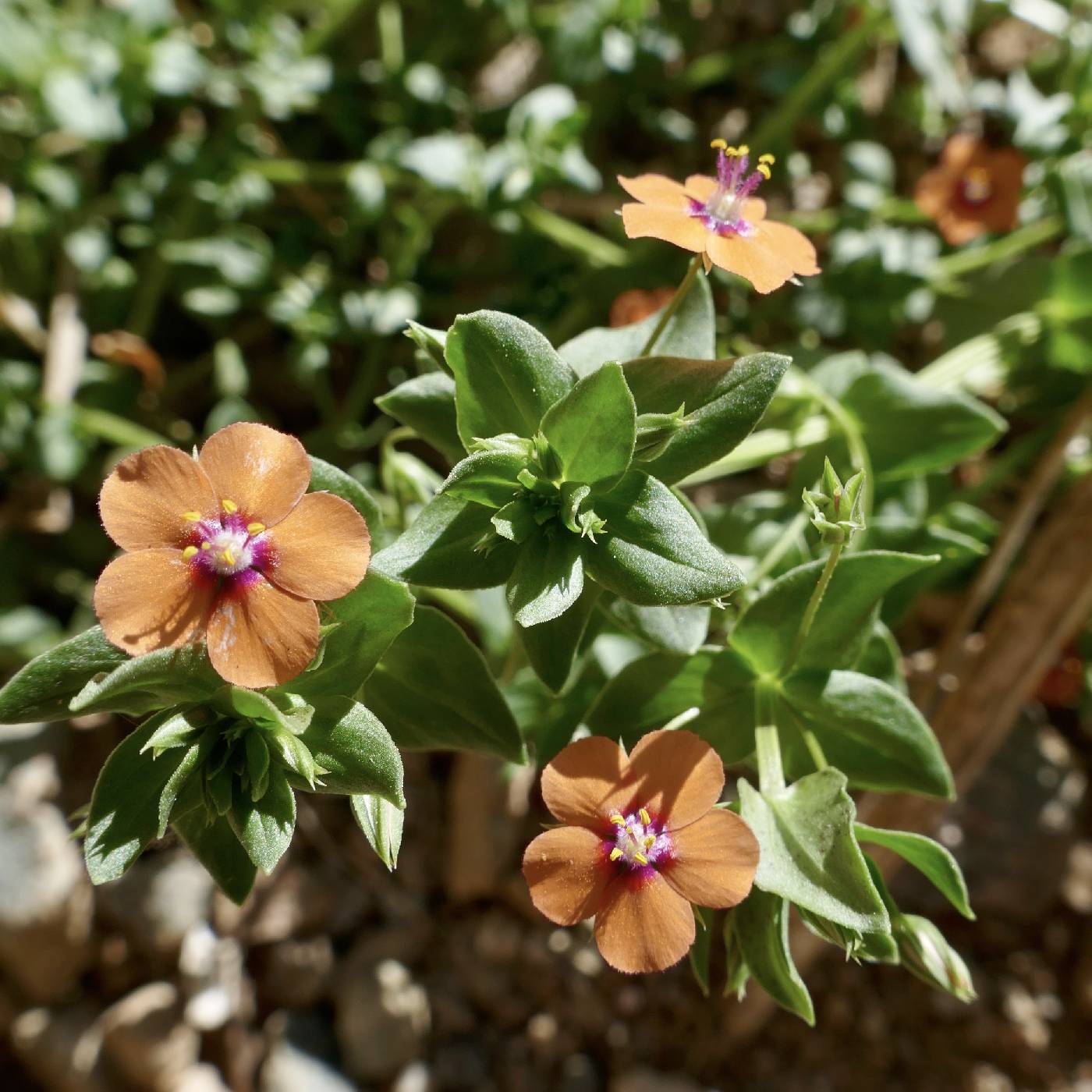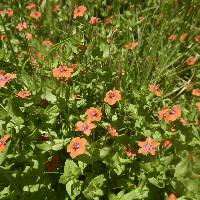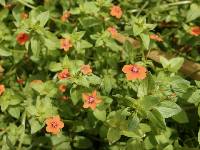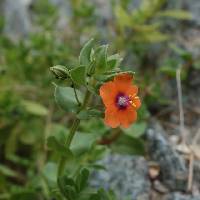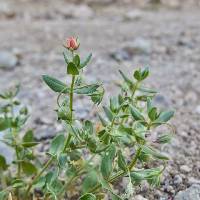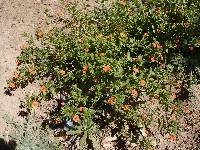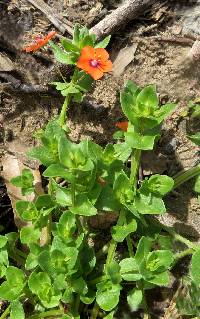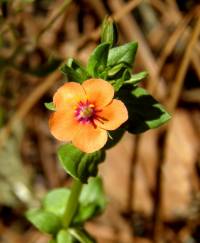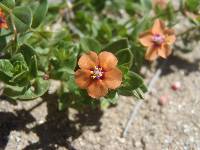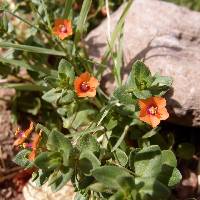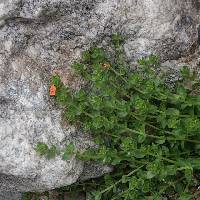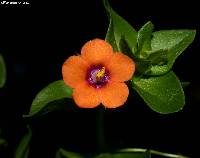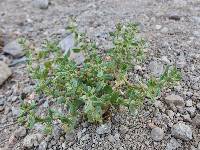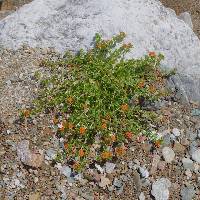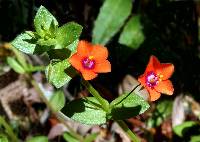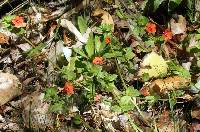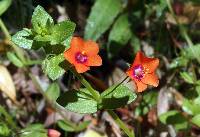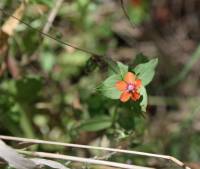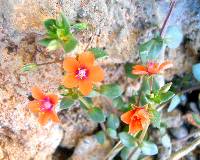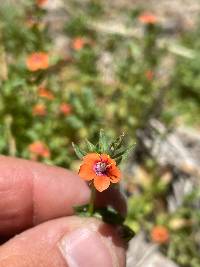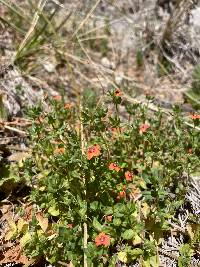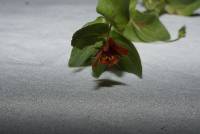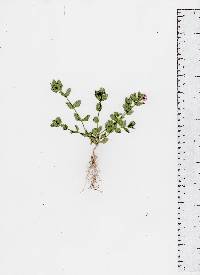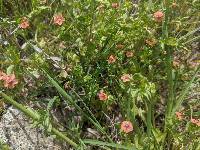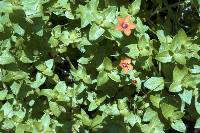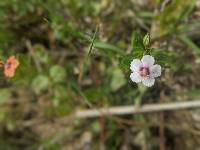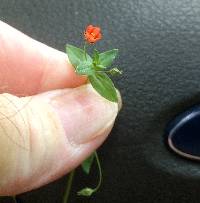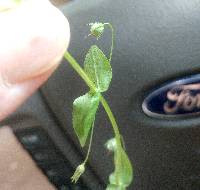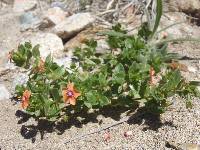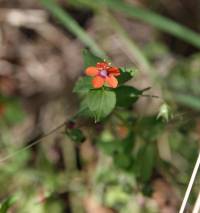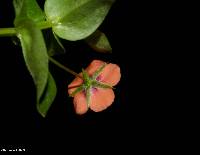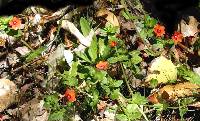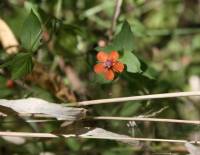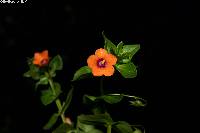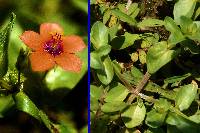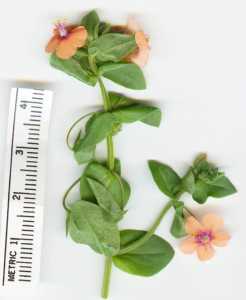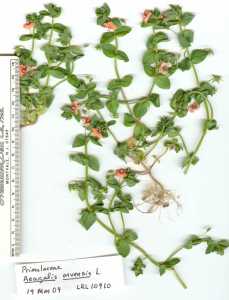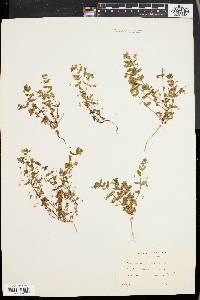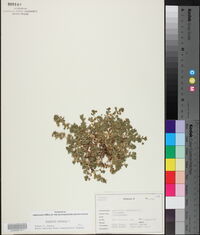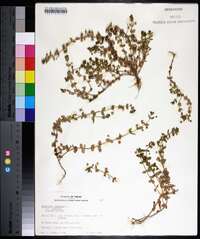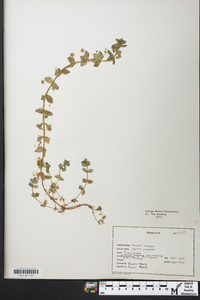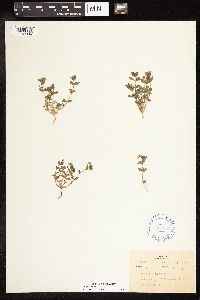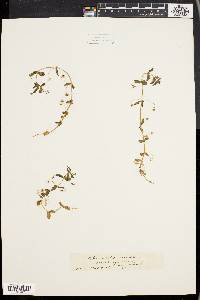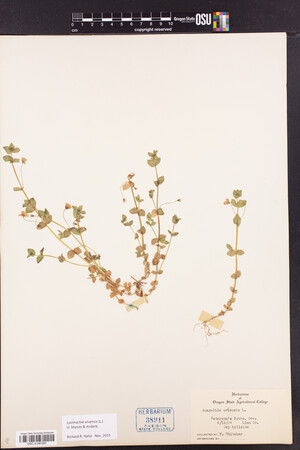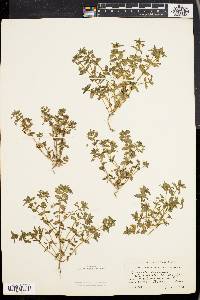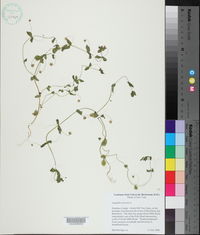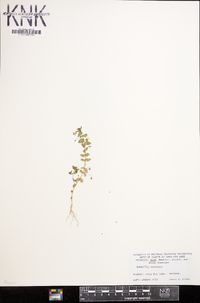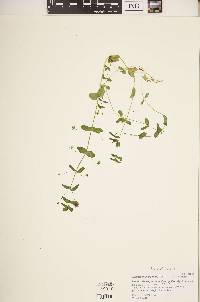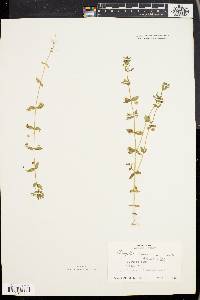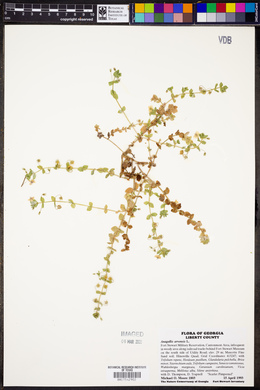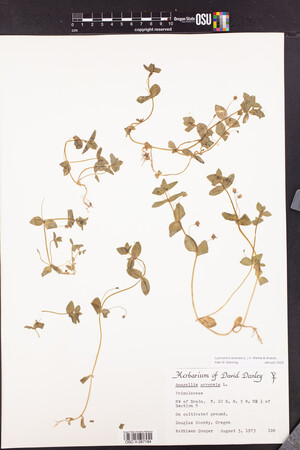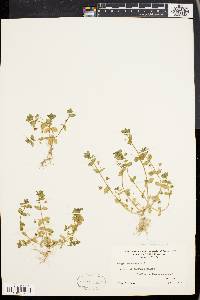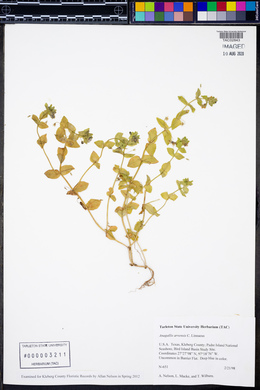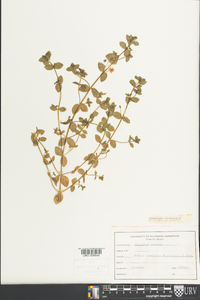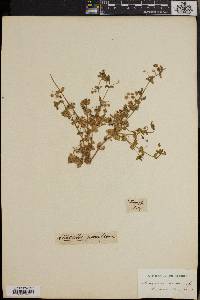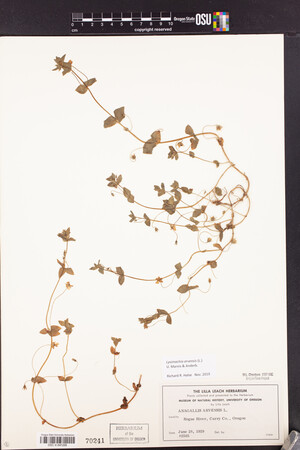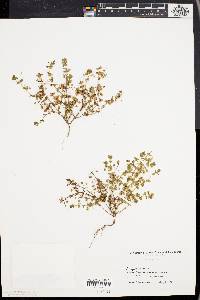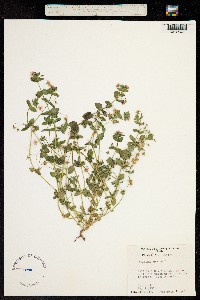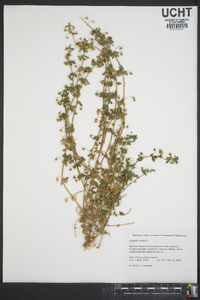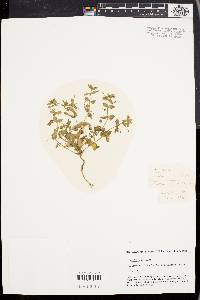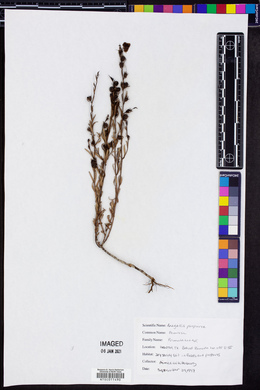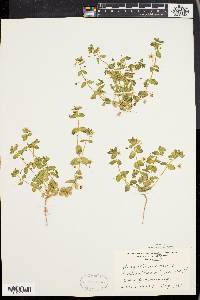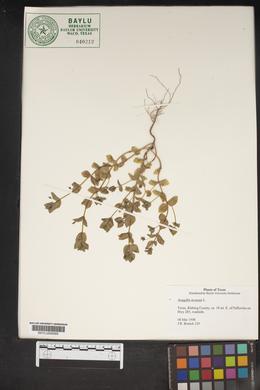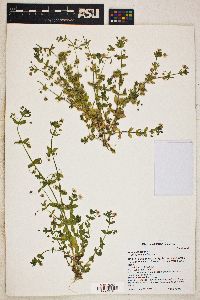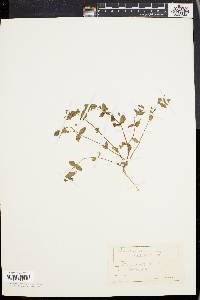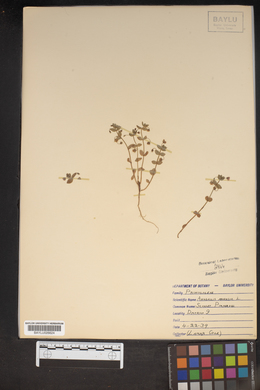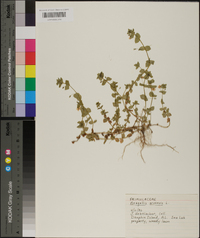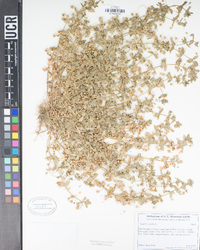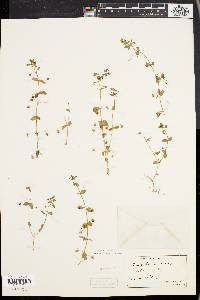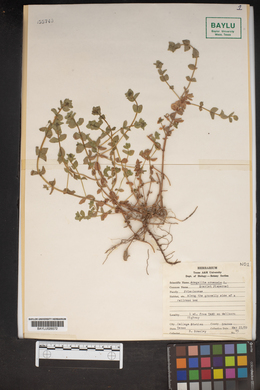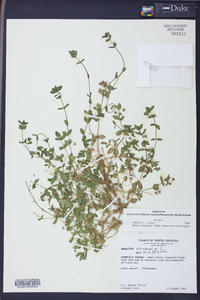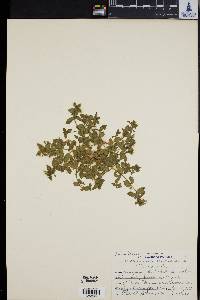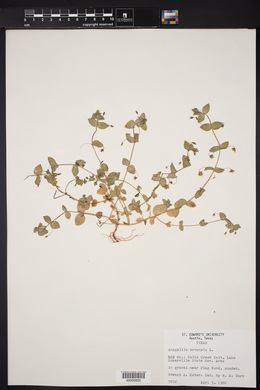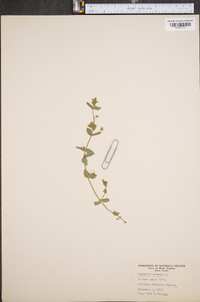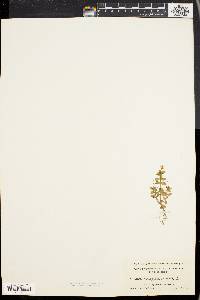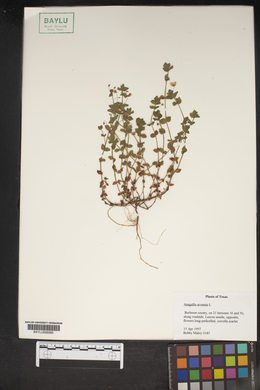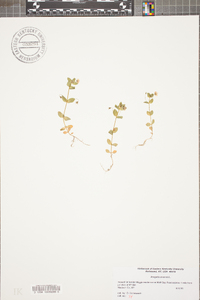
|
|
|
|
Family: Primulaceae
Scarlet Yellow-Loosestrife, more...salmon pimpernel, pimpernel, scarlet pimpernel (es: hierba de pájaro)
[Anagallis arvensis L., moreAnagallis arvensis arvensis , Anagallis arvensis f. arvensis , Anagallis arvensis subsp. latifolia (L.) Arcang., Anagallis arvensis var. coerulea , Lysimachia arvensis subsp. latifolia (L.) Peruzzi] |
Plants annual (rarely perennial). Stems ascending or erect, 0.6-5 dm. Leaves usually opposite, sometimes whorled distally; blade ovate to elliptic or lanceolate, 5-30 × 4-10 mm. Pedicels recurved in fruit, 3-35 mm, longer than subtending leaf. Flowers: sepals 5, calyx divided nearly to base, 3.5-5 mm, ± equaling corolla, margins entire or minutely crenulate, broadly scarious, apex acute to acuminate; petals 5, corolla salmon, red, or blue, salverform (almost rotate), (2-)3-7(-10) mm. Capsules 4-6 mm. Seeds 12-45. 2n = 40. Flowering spring-summer. Open, disturbed sites; 0-1200 m; introduced; Greenland; B.C., N.B., N.S., Ont., Que.; Ala., Ariz., Ark., Calif., Colo., Conn., Del., D.C., Fla., Ga., Idaho, Ill., Ind., Iowa, Kans., Ky., La., Maine, Md., Mass., Mich., Miss., Mo., Mont., Nebr., Nev., N.H., N.J., N.Mex., N.Y., N.C., Ohio, Okla., Oreg., Pa., R.I., S.C., Tenn., Tex., Utah, Vt., Va., Wash., W.Va., Wis.; Eurasia; nearly cosmopolitan; introduced also in Mexico. Canadian populations of Anagallis arvensis are primarily found in southern coastal regions and the lower Great Lakes. The species has been reported also from Alberta, Newfoundland, Prince Edward Island, Saint Pierre and Miquelon, Saskatchewan, and Minnesota; it is not established in those areas. The flowers close on cloudy days and as evening approaches, hence the name weatherglass. P. E. Gibbs and S. Talavera (2001) found that Anagallis arvensis self-pollinates as the petals close.
Plant: Annual herb; 5-45 cm long, with prostrate stems Leaves: cauline, opposite, 0.5-2 cm long, sessile; blade ovate, glabrous Flowers: orange or salmon-colored to scarlet; calyx deeply lobed, 2-7 mm long; corolla deeply lobed, 2-7 mm long, the lobes with stalked glands on the outer margins, stamens 5; ovary superior Fruit: circumscissile capsules Misc: Moist meadows, stream banks, pond edges and moist disturbed areas; 300-1650 m (1000-5400 ft); Mar-Jun REFERENCES: Cholewa Anita F. 1992. Primulaceae. Ariz.-Nev. Acad. Sci. 26(1)2 FNA 2009, JANAS 26(1), Kearney and Peebles 1969 Duration: Annual Nativity: Non-Native Lifeform: Forb/Herb General: Herbaceous annuals, biennials or rarely perennials, stems to 50 cm tall, prostrate or ascending to erect. Leaves: Opposite, sometimes whorled distally, sessile, ovate to elliptic or lanceolate, 5-30 mm long and 4-10 mm wide, margins entire to shallowly dentate, surfaces glabrous. Flowers: Red to salmon-colored or blue with 5 lobes on a short tube, 3-7 mm long, corollas salverform to rotate, the lobes denticulate and bearing glands stalked on globose hairs on the margins, sepals 5, calyx 2-7 mm long, deeply lobed and divided nearly to the base, stamens distinct, inserted on the corolla opposite the lobes, filaments bearded, style and stigma solitary, flowers borne on peduncles surpassing the leaves and recurved in fruit. Fruits: Circumsessile capsule (opening at the top like a lid) 4-6 mm long. Seeds 12-45. Ecology: Found in moist meadows, stream banks, pond edges, and wetted open and disturbed areas from 0-5,500 ft (0-1676 m); flowering spring-summer. Distribution: Widely distributed in North America. Naturalized from Europe. Ethnobotany: There is no specific use recorded for the species, but the genus has uses; an infusion of the plant was taken for gonorrhea when the bladder and urinal tract failed. Synonyms: None Editor: LCrumbacher 2011 Etymology: Anagallis comes from two Greek words, ana, "again," and agallein, "to delight in," since the flowers open each time the sun strikes them and we can enjoy them anew each day, while arvensis means "of the fields." Annual, usually much-branched, diffuse to erect, 1-3 dm; stem 4-angled; lvs sessile, decussate, elliptic to ovate, 1-2 cm; fls solitary in the axils; pedicels slender, ascending, in fr recurved; sep 3-4 mm; cor equaling or somewhat surpassing the cal, open only in fair weather; 2n=40. Native of Eurasia, now a weed in temperature regions almost throughout the world, sometimes along salted highways. The common var. arvensis has scarlet or brick-red to sometimes white fls on pedicels that usually exceed the lvs. Var. caerulea (Schreb.) Gren. & Godr., rare in our range, mostly more southern than var. arvensis in Europe, has blue fls on pedicels usually shorter than the lvs. Gleason, Henry A. & Cronquist, Arthur J. 1991. Manual of vascular plants of northeastern United States and adjacent Canada. lxxv + 910 pp. ©The New York Botanical Garden. All rights reserved. Used by permission. From Flora of Indiana (1940) by Charles C. Deam Our specimens are from clover, wheat, and abandoned fields, waste places about habitations, and rarely in open places in nearby woods. .…… Indiana Coefficient of Conservatism: C = null, non-native Wetland Indicator Status: FACU |
|
|
|

